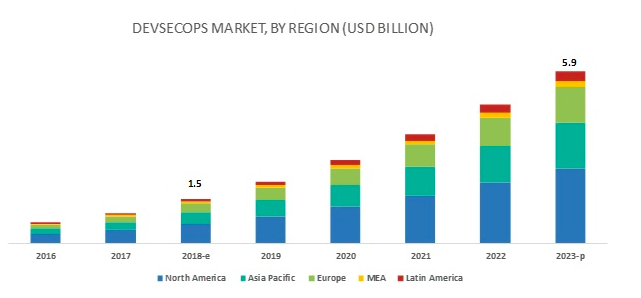The Analytical Research Cognizance says that the global DevSecOps market is expected to grow at a CAGR of 33.7% during the forecast period 2017-2023.
Security threats are a reality of today’s digital world thriving on everyday technology. Widespread rumors and viral content has blurred the security lines. However, it is still a big concern among IT leads and teams. Organizations cannot afford the hampering and security breaches in their systems.
Focusing on instilling a secure culture, DevSecOps drives the IT department to align processes with the business objectives. Delivering appropriate features and fixes for your concerns, DevSecOps makes the cloud environments a better place to develop products.

Pillars of DevSecOps
Like every concept, DevSecOps has a strong base of principles and elements that which withholds the strength. These four fundamental pillars of DevSecOps are what drives the strategies across security and compliance:
People
Resources of an organization are an important catalyst in the growth of DevSecOps as they help in breaking the traditional barriers of operations. Innovating with a team that values the shared goal leads to transparency, accountability, and ownership. Initiating in small teams can always develop confidence which can be taken forward to other teams. Only with a deeper understanding of cybersecurity approaches among the personnel, we can adopt secure coding practices and efficiency.
Process
Along with speed and quality, consistency is what organizations should incorporate in their processes. Adopting practices like thinking design specific for customers, implementing threat modeling storyboards, and incremental static code scanning before the application is packaged can eliminate the security breaches and rework.
DevSecOps drives the IT department to align processes with the business objectives
Technology
Cybersecurity software is keeping pace with the pipeline tools such as security-as-code, testing-as-code and infrastructure-as-code to eradicate manual security activities and boost velocity. Unifying the teams, the pipelines become better at deployment and development of specific products.
Governance
Organizations build a scalable and designed framework (at a micro and macro level) that serves development and collaborations. On the micro-level, the governance of tools and processes help in boosting efficiency and accomplishes tasks in no time. On the macro level, the descent of hierarchical structures showcases the rise of products developed using DevOps.
What makes DevSecOps important?
Active DevSecOps implementations allow enterprises to repair flaws over 11.5 times quicker due to regular security checks throughout the software that builds and produces updates.
Since its now more than ever an important time to build the credibility of processes in the market, the core strength of DevSecOps is the ability to provide secure deliverables. It empowers professionals to create secure codes with agile techniques and harness the highest of security without undermining the company goals. In addition, the growing demand for AI, cloud environments and automation brought the needed spotlight towards DevSecOps. Even cloud providers, which are taking over a major market share, ensure security at each stage during the product development process.
Benefits of Shifting to Cloud-Native Security
For organizations with traditional silos, DevSecOps is an instrument to break barriers and embrace the cost-effective ways of providing a safe space for development. The cloud-native technologies create integrated and continuous security at every stage of the application and the infrastructure lifecycle. The three-fold benefits include:
- Cloud-native features and APIs provision greater efficiency
- Superior performance than non-native solutions
- Native security applications use cloud services for delivery and cloud APIs for control that leads to broader scalability
Flexible and extensible security for multi-cloud environments that connects every security iteration to a centralized management console can enable various possibilities like, unified policy creation, distribution, orchestration, enforcement, and management of the cloud-native applications.
Hot Trends in DevSecOps
The future looks like 100% automated with DevSecOps
As enterprises are moving towards building secure software systems, the future looks like 100% automated with DevSecOps. For the strategies to be executed, DevOps and IT teams will require effective collaborations toward the common goal of security.
For instance, NoOps (No Operations) is already trending as we speak. Leveraging AI and intelligent automation, self-service and reduced dependencies of operations can become a reality soon.
Similarly, as the organizations are increasing the usage of data-driven applications, they are moving towards applying machine learning to operations and opening room for predictive suggestions that streamline optimized deliveries and greater insights.
Case Study
How NIAID prioritized culture change and brought DevSecOps transformation
A recent research by The National Institute of Allergy and Infectious Diseases (NIAID) was conducted. The IT team of NIAID works to “future proof” itself to provide timely and secure support to researchers who conduct and manage key research projects. Along with DevOps, the organization has initiated the automation of security to protect sensitive health data.
“By implementing a DevSecOps approach, we can run scans and put specific, consistent security protocols in place. When we’re using these techniques, we can be very confident in what our servers look like, and if there’s a problem, we can fix it consistently by changing the code”, acknowledges Joe Croghan, chief of NIAID’s software engineering branch.
Moving Forward
It is expected from the APAC region to offer growth opportunities for the market during the forecast period. These rapid integrations of multiple cloud technologies have led enterprises to adopt DevSecOps solutions and services and advance with end-to-end security for their applications and tools.
Subscribe
Related Blogs
Trek n Tech Annual Retreat 2025: A 7-Day Workcation of OSL

OSL family came together for the Trek n Tech Annual Retreat 2025, a 7-day workcation set amidst the serene beauty of…
Exploring Drupal's Single Directory Components: A Game-Changer for Developers

Web development thrives on efficiency and organisation, and Drupal, our favourite CMS, is here to amp that up with its…
7 Quick Steps to Create API Documentation Using Postman

If you work with API , you are likely already familiar with Postman, the beloved REST Client trusted by countless…




